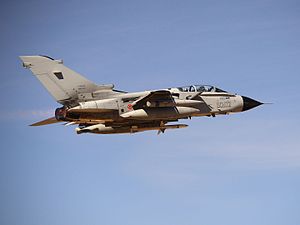Altomare E.93 Ciclone
| Altomare E.93 Ciclone | |
|---|---|

| |
| An E.93 aircraft of the 29° Squadrone Guerra Elettronica, 4° Stormo "Stregone" | |
| Role | Electronic warfare |
| National origin | |
| Manufacturer | Altomare Aviation |
| First flight | June 21, 1989 |
| Introduction | 1993 |
| Status | In service |
| Primary user | Lumenic Air Force |
| Developed from | Altomare A.79 Ciclone |
The Altomare E.93 Ciclone is a twin-engine, variable-sweep wing strike fighter developed for the Lumenic Air Force by Altomare Aviation from the A.79 Ciclone fighter-bomber to serve as a dedicated electronic-warfare aircraft to serve as both an escort for airceaft serving as an electronic countermeasures platform, as well as preforming Suppression of Enemy Air Defenses missions against hostile surface-to-air missile and anti-aircraft sites as well early warning and command and control facilities. This aircraft replaced the Licanan Defense Industries M-33 in the SEAD role and supplemented the Belloli EB.54 in electronic countermeasures duties before it was replaced by the more capable Tancredi E.06 Argento.
The E.93 entered service with the Lumenic Air Force in March of 1993, just prior to the end of the Omandan Continental War and saw some limited combat use. It has bene deployed in several other conflicts since, including the 1997 Sable Conflict between Luminerra and Notreceau. While often used for electronic countermeasure support, the primary mission of the E.93 is Suppression of Enemy Air Defenses; the countering of hostile antiaircraft capabilities prior to operations conducted in an area by convention strike craft. To accomplish this, the E.93 is equipped with a variety of specialized systems that allow to not only acquire, track and home in on radar emissions, but to evade hostile surface to air missiles while doing so. The primary weapon carried by the E.93 is the AAM-12 anti-radiation missile, which is used to engage radar systems providing targeting and acquisition information for surface to air missiles.
Currently, the Lumenic Air Force is the only operator of the E.93 Ciclone, with 36 in operational service. These aircraft are assigned to the 29° Squadrone Guerra Elettronica, 4° Stormo "Stregone" based at Terni Royal Air Force Base in Istia and the 36° Squadrone Guerra Elettronica, 14° Stormo "Giullare" based out of Saleit Royal Air Force Base in Pasa, and the 41° Squadrone Guerra Elettronica, 70° Stormo "Mago" located at Vallona Royal Air Force Base, Librari
History and development
Operational history
eE.93 Ciclone partcipated in several operations in the closing days of the Omandan Continental War, providing electronic countermeasure support to Allied fighter and attack aircraft operating in central Omand, as well as conducting numerous suppression of enemy air defense operations against Soviet Order surface to air missile and early warning radar instillations. In total, 19 aircraft were lost in combat operations against Soviet Order forces between 1993 and the end of the war in 1994.
E.93 aircraft participated in Operation Two Fold, one of the final offensive of the war, aimed at liberating the city of Poleka. Poleka at the time, was considered part of the city of Rakitna, forming the Greater Rakitna Area, a conurbation consisting of Poleka in present day Krasno, Rakitna in the Ekspander SSR, and several larger urban areas supporting the two metropolises. The Great Bridge of Peace of Prosperity, a massive series of land bridge constructed by the Order of Soviet Socialist Republics between 1954 and 1971, linked the two cities across the Krasno Sea. The city was a center of commence and shipbuilding, and home to the Soviet Seventh Fleet, a green water force tasked with patrolling and defending the Krasno Sea, Gulf of Ekspander, and the Straits of Orzesze, including the vital Lubań Canal in present day <?>. With a combined population of nearly 18 million citizens, the Allies predicted that the Soviets would fight fiercely to hold the city. Lumenic Air Force E.93 aircraft did not participate in the initial assaults Greater Rakitna, which began in 1991, but did participate in combat operations against targets within the city, which were often situated in areas with high civilian population concentrations, or atop buildings the Lumenic Air Force did not wish to target, such as schools, hospitals, or religious establishments. Historian Emma Aloise of the Vellai University's School of History estimated that Allied airstrikes likely accounted for upward of 4,000 civilian deaths within the Greater Rakitna Area.
Operators
 Luminerra
Luminerra
- Lumenic Air Force - The Lumenic Air Force has three operations squadrons equipped with the E.93 Ciclone for a total of 36 aircraft
Specifications
General characteristics
- Crew: 2
- Length: 18.68 m (61 ft 3 in)
- Wingspan: 13.91 m (45 ft 8 in)
- Height: 5.95 m (19 ft 6 in)
- Wing area: 26.6 m2 (286 sq ft)
- Empty weight: 14,500 kg (31,967 lb)
- Max takeoff weight: 27,986 kg (61,699 lb)
- Powerplant: 2 × Vaccari AE-2141 afterburning 3-spool turbofan, 40.5 kN (9,100 lbf) thrust each dry, 73.5 kN (16,500 lbf) with afterburner
Performance
- Maximum speed: 2,400 km/h (1,491 mph; 1,296 kn) / M2.2 at 9,000 m (29,528 ft)
- Combat range: 1,853 km (1,151 mi; 1,001 nmi)
- Ferry range: 4,265 km (2,650 mi; 2,303 nmi)
- Endurance: 2 hr combat air patrol at 560–740 km (348–460 mi) from base
- Service ceiling: 15,240 m (50,000 ft)
Armament
- Guns
- 1 × 30 mm Srad CDR-3080 cannon with 180 rounds (internally mounted under starboard side of fuselage)
- Hardpoints: 10 total (4× semi-recessed under-fuselage, 2× under-fuselage, 4× swivelling under-wing) holding up to 9000 kg (19,800 lb) of payload, the two inner wing pylons have shoulder launch rails for 2 × short-range anti-air missiles each
- Others:
- Up to 2× drop tanks for extended range/loitering time. Up to 4 drop tanks for ferry role
